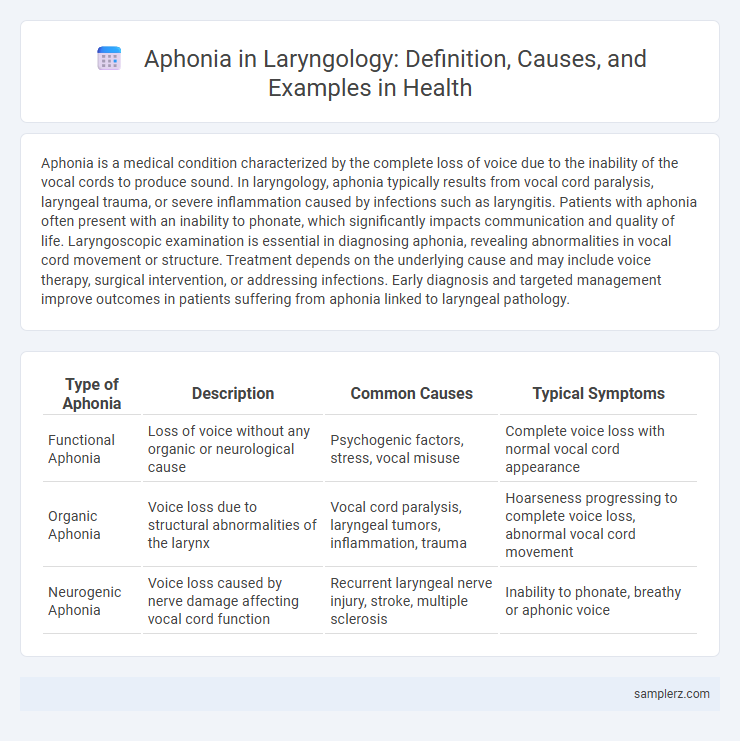Aphonia is a medical condition characterized by the complete loss of voice due to the inability of the vocal cords to produce sound. In laryngology, aphonia typically results from vocal cord paralysis, laryngeal trauma, or severe inflammation caused by infections such as laryngitis. Patients with aphonia often present with an inability to phonate, which significantly impacts communication and quality of life. Laryngoscopic examination is essential in diagnosing aphonia, revealing abnormalities in vocal cord movement or structure. Treatment depends on the underlying cause and may include voice therapy, surgical intervention, or addressing infections. Early diagnosis and targeted management improve outcomes in patients suffering from aphonia linked to laryngeal pathology.
Table of Comparison
| Type of Aphonia | Description | Common Causes | Typical Symptoms |
|---|---|---|---|
| Functional Aphonia | Loss of voice without any organic or neurological cause | Psychogenic factors, stress, vocal misuse | Complete voice loss with normal vocal cord appearance |
| Organic Aphonia | Voice loss due to structural abnormalities of the larynx | Vocal cord paralysis, laryngeal tumors, inflammation, trauma | Hoarseness progressing to complete voice loss, abnormal vocal cord movement |
| Neurogenic Aphonia | Voice loss caused by nerve damage affecting vocal cord function | Recurrent laryngeal nerve injury, stroke, multiple sclerosis | Inability to phonate, breathy or aphonic voice |
Defining Aphonia: A Core Symptom in Laryngology
Aphonia, characterized by the complete loss of voice, is a core symptom in laryngology indicating significant vocal fold dysfunction. Common causes include vocal fold paralysis, severe laryngeal inflammation, or traumatic injury to the vocal cords. Accurate diagnosis through laryngoscopic examination is essential for identifying the underlying etiology and guiding effective treatment strategies.
Common Causes of Aphonia in Patients
Aphonia, characterized by the complete loss of voice, commonly results from vocal cord paralysis, laryngeal trauma, or severe laryngitis. Patients with vocal fold nodules or polyps may also experience aphonia due to impaired vocal cord vibration. Neurological conditions such as recurrent laryngeal nerve injury further contribute to this condition in laryngology practice.
Organic Aphonia: Structural Laryngeal Disorders
Organic aphonia is characterized by the loss of voice due to structural abnormalities in the larynx, such as vocal fold paralysis, laryngeal tumors, or vocal fold scarring. These structural laryngeal disorders disrupt normal vocal fold vibration and closure, leading to complete voice loss or significant dysphonia. Diagnosis often involves laryngoscopy and imaging studies to identify the precise anatomical cause and guide targeted treatment approaches like surgery or voice therapy.
Functional Aphonia: Psychogenic Versus Habitual Causes
Functional aphonia in laryngology manifests as loss of voice without organic pathology, often classified into psychogenic and habitual origins. Psychogenic aphonia arises from emotional or psychological stress causing involuntary vocal fold dysfunction, whereas habitual aphonia results from learned voice misuse or maladaptive vocal behavior. Understanding the distinction is crucial for targeted therapeutic interventions, with psychogenic cases benefiting from psychological support and habitual cases requiring voice therapy.
Neurological Aphonia: Nerve Injury and Vocal Fold Paralysis
Neurological aphonia often results from nerve injury affecting the recurrent laryngeal nerve, leading to vocal fold paralysis. This paralysis disrupts vocal fold adduction, causing significant voice loss or a breathy, whisper-like voice. Diagnosis typically involves laryngoscopy and electromyography to assess nerve function and guide targeted voice therapy or surgical intervention.
Aphonia After Laryngeal Surgery: Case Examples
Aphonia after laryngeal surgery commonly results from vocal cord paralysis or trauma to the recurrent laryngeal nerve, leading to complete loss of voice. Case studies reveal patients experiencing sudden aphonia post-thyroidectomy, where nerve damage impairs vocal fold mobility. Effective management often involves voice therapy and, in some cases, surgical interventions such as medialization thyroplasty to restore phonation.
Traumatic Aphonia: Acute Injury and Laryngeal Trauma
Traumatic aphonia occurs when acute injury to the larynx causes a sudden loss of voice, often resulting from blunt force trauma or penetrating injuries that damage the vocal cords. Laryngeal trauma leads to edema, hematoma, or fractures of laryngeal cartilages, disrupting normal vocal fold vibration and airflow necessary for phonation. Immediate diagnosis and management are critical to restore airway patency and voice function, utilizing imaging techniques like CT scans and interventions such as corticosteroids or surgical repair.
Infectious Aphonia: Laryngitis and Related Infections
Infectious aphonia primarily results from laryngitis caused by viral or bacterial infections that inflame and damage the vocal cords, leading to complete loss of voice. Common pathogens include influenza virus, adenovirus, and Streptococcus species, which provoke mucosal swelling and impair vocal fold vibration. Prompt diagnosis and treatment with antiviral or antibiotic agents, along with voice rest, are crucial for restoring phonation and preventing complications.
Pediatric Aphonia: Unique Cases in Children
Pediatric aphonia, characterized by the complete loss of voice in children, often results from congenital anomalies, vocal cord paralysis, or psychogenic causes such as selective mutism. Laryngoscopy frequently reveals normal vocal cord anatomy in psychogenic aphonia, distinguishing it from structural lesions. Early diagnosis and multidisciplinary intervention, including speech therapy and psychological support, are crucial for effective pediatric aphonia management and voice restoration.
Diagnosis and Management Strategies for Aphonia
Aphonia, characterized by the complete loss of voice, often results from vocal cord paralysis, laryngeal trauma, or neurological conditions such as recurrent laryngeal nerve injury. Diagnosis typically involves laryngoscopy to visualize vocal fold motion and electromyography to assess neuromuscular function. Management strategies include voice therapy to improve vocal fold closure, surgical medialization procedures like thyroplasty, and addressing underlying neurological or structural causes to restore phonation.

example of aphonia in laryngology Infographic
 samplerz.com
samplerz.com